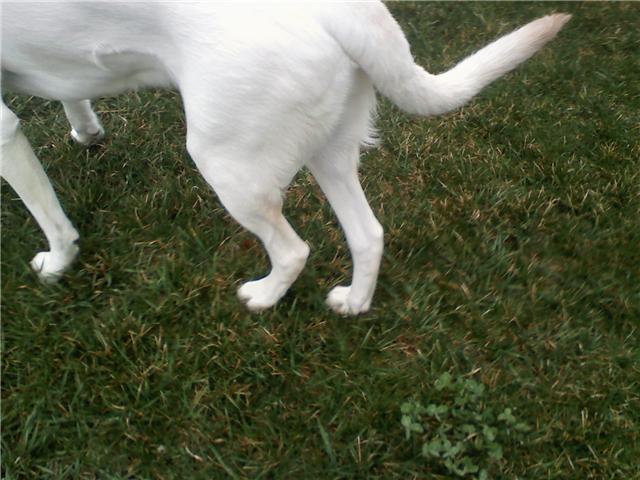
While the condition begins as a puppy you usually wont notice symptoms until your Labrador is around two years old. Do not expect your puppy to have been tested before you purchase them as none of the currently available tests are valid for puppies under the age of 4 months.

1 All puppies are born with perfectly normal hips Hip dysplasia is not a congenital defect.
What age do labs show hip dysplasia. Other common Lab joint problems include osteoarthritis from old age and not necessarily hip dysplasia and elbow dysplasia which can result in lameness of the front legs. Always consult your veterinarian if you see the symptoms of Labrador hip dysplasia. X-rays and a full exam are necessary for proper diagnosis.
Labrador Hip Dysplasia Surgery. By the time a dog has reached two years of age almost 95 of CHD cases reveal themselves. This is why it is vital to only buy puppies from breeders who have tested the parents for both hip dysplasia and elbow dysplasia which is the same joint deformity in the elbow socket.
Hip dysplasia is the name for the abnormal hip joint. Hip Dysplasia In Puppies Puppies are rarely diagnosed with hip dysplasia until they are at least six months old. It is most often diagnosed between 6 and 18 months of age.
Labrador Retriever puppy dog hip dysplasia. The left hip positioned on the right side in the X-ray is worse than the right hip with only slight coverage of the head of the femur by the acetabulum. The disease can occur in Labs that are just a few months old or it.
Some dogs begin to show signs of hip dysplasia when they are as young as four months of age. Others develop it in conjunction with osteoarthritis as they age. In both cases there are a few.
The most common cause of hip dysplasia in dogs is solely based on genetics. Large breed dogs such as the Great Dane Labrador Retriever Golden Retrievers St. Bernard and German Shepherd dogs are among those canines who have the genetic predisposition for.
What is hip dysplasia. Our hips and the hips of our dogs are ball and socket joints. And for these joints to work properly the ball part which is the bulbous end at the top of the long thigh bone must fit neatly into the socket which is a part of the pelvis.
Your dogs back legs need to swing smoothly back and forwards as he moves. For dogs that are between 4 months and 23 months of age preliminary screenings are available. Hip Dysplasia Treatment Options.
Once osteoarthritis is present on a radiograph dysplastic changes are irreversible and usually continue to progress over time. If a dysplastic dog has secondary arthritis and pain most owners elect to first treat their dog with medical management. These changes can manifest as pain in dogs as young as 4 months of age.
As dogs age hip dysplasia results in the breakdown of cartilage which serves as a shock absorber for joints. The bone beneath the damaged cartilage also undergoes changes. These structural changes lead to inflammation and the condition known as osteoarthritis.
While early X-rays show a normally shaped ball and socket. Biomechanical changes caused by joint laxity or malformation of the hip bone socket can show in puppies. This can be as young as 2 months old.
Breeds Prone to Hip Dysplasia Many dogs are prone to hip dysplasia. For Labradors that are genetically prone to hip dysplasia symptoms can occur in puppies that are just a few months old or they can strike later in a dogs life. HIP DYSPLASIA IN LABRADORS WHAT IS IT.
Hip dysplasia is a degenerative condition which can affect any dog. Although the causes may vary the effects are always the same. Loss of mobility increasing pain impaired gait even.
English Labradors who do have hip or elbow dysplasia should not be used as a breeding dog since these genetic diseases that are passed from parents to offspring. Dogs under 2 years of age can only be given a preliminary screen. They cannot get their full certification until they are 2 years old.
Hip dysplasia will get worse with age and older dogs will often start to struggle with their mobility. This can include being unable to climb stairs jump onto or off a couch or run like they once did. This level of hip dysplasia can be managed though with adjustments in lifestyle as your dog gets older.
Genetic not environmental typically manifests bilaterally in both hips usually before the age of 10 months - but an early injury to one leg that goes untreated for too long can result in dysplasia of a lesser degree in the leg that compensates for the injury so even this being genetic rather than environmental is questionable. There are some simple things we could do to reduce the incidence of hip dysplasia now if we understand a few basic things. Here are the 10 most important things you need to know.
1 All puppies are born with perfectly normal hips Hip dysplasia is not a congenital defect. When it comes to elbow and hip dysplasia in dogs symptoms will start mild and become more severe over time. While the condition begins as a puppy you usually wont notice symptoms until your Labrador is around two years old.
If you spot any abnormalities monitor them closely to see if symptoms worsen. Up to 10 cash back Hip Dysplasia at a glance. 1 Hip dysplasia is the result of improbably formed hip joints.
2 Puppies as young as five months old can develop hip dysplasia. 3 While the primary cause of hip dysplasia is genetics diet and exercise can also be factors. 4 There is no cure for hip dysplasia but there are ways to make your dogs life more comfortable.
Do not expect your puppy to have been tested before you purchase them as none of the currently available tests are valid for puppies under the age of 4 months. The science of detecting Hip Dysplasia in dogs is still in its infancy.